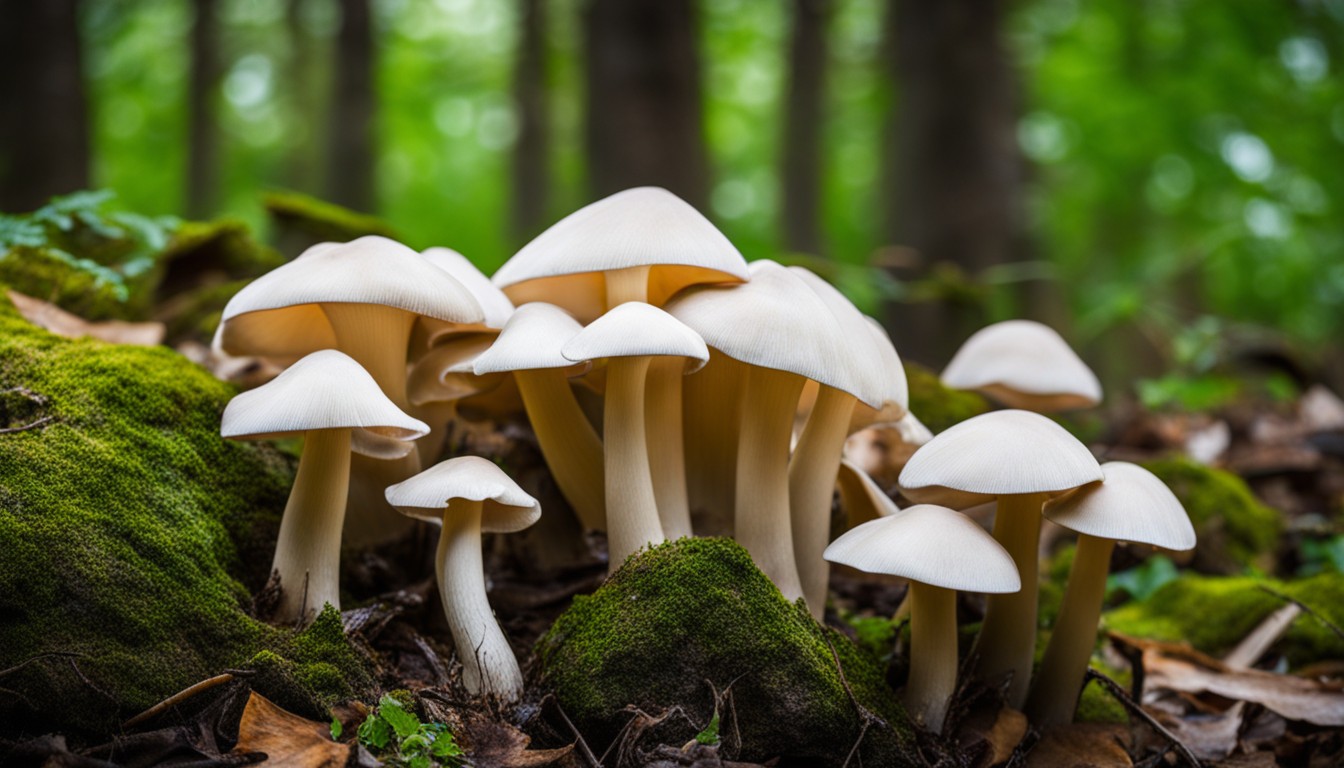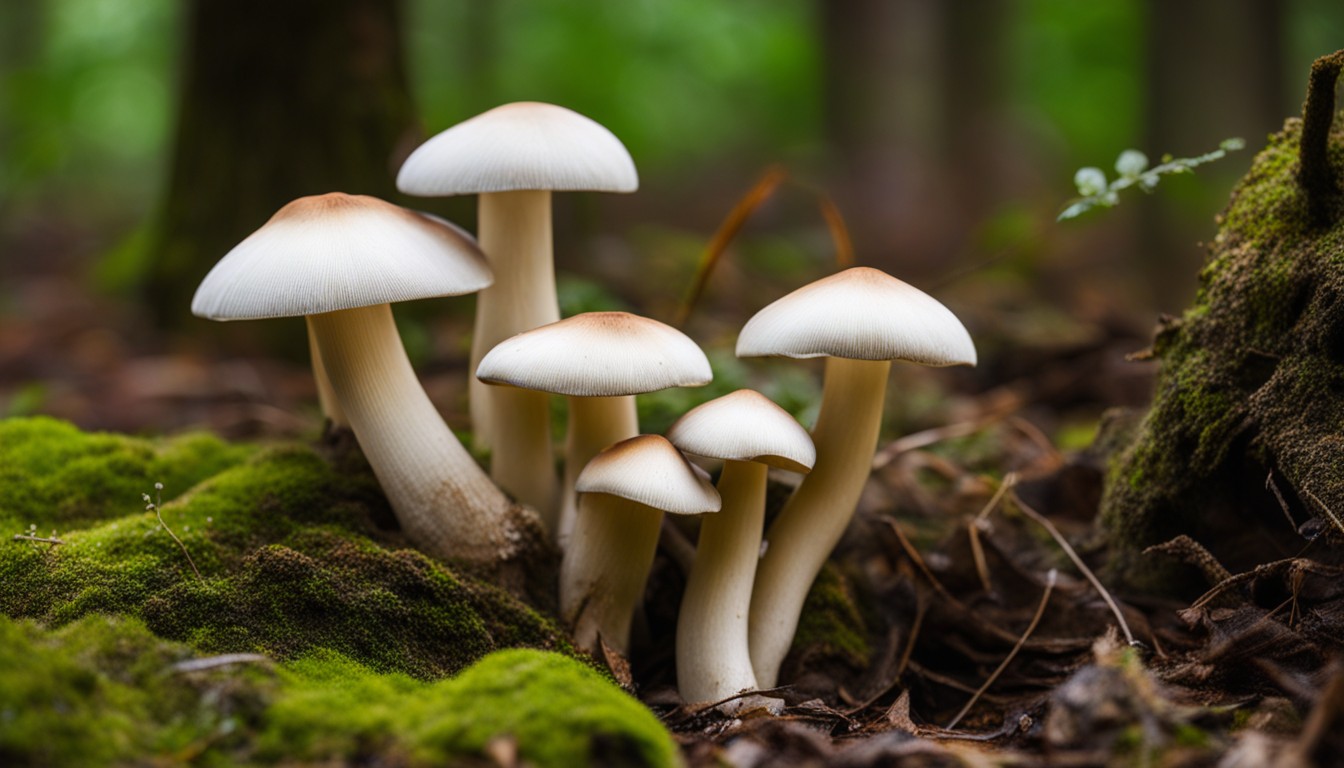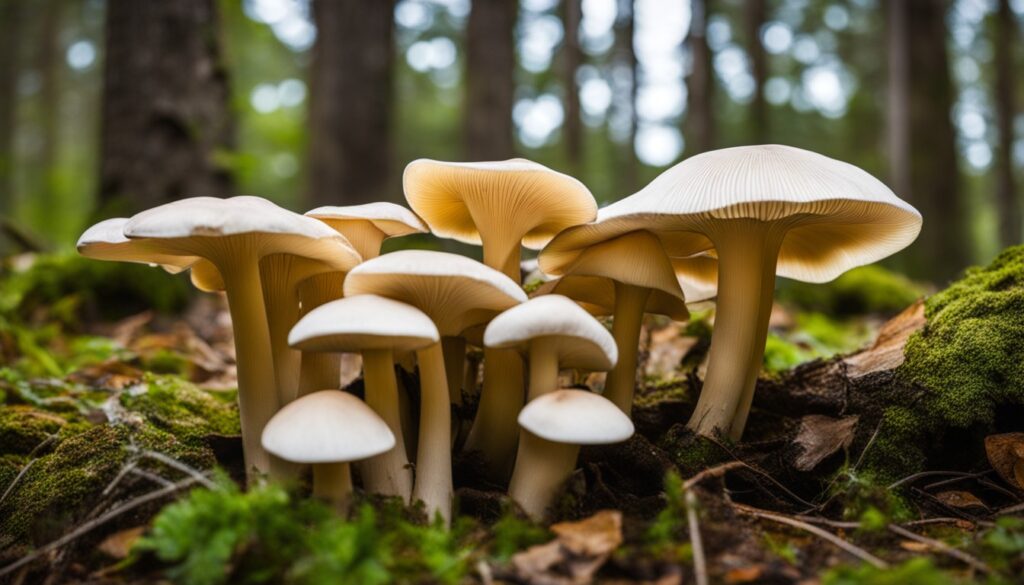North Carolina is renowned for its diverse array of wild mushrooms, making it a haven for mushroom enthusiasts and foragers alike. From the majestic and sought-after morel to the vibrant and delectable chanterelle, the Tar Heel State is a treasure trove of fungal wonders. Whether you’re a seasoned mushroom hunter or a curious nature lover, exploring the fascinating world of North Carolina’s wild mushrooms is an adventure waiting to be had. Join us as we delve into the enchanting forests, uncover the hidden gems, and learn about the unique characteristics of these captivating fungi. Embark on a journey of discovery and deepen your appreciation for the natural wonders that abound in the bountiful wilderness of North Carolina.
Identifying North Carolina Wild Mushrooms
From the distinctive caps of Amanita species to the telltale flush of Chanterelles, identifying mushrooms in North Carolina is an exercise in appreciating the diversity of nature. Observation, patience, and reliable field guides give amateur mycologists the tools needed to correctly identify these fungi.
Understanding the Tar Heel State’s Fungal Biodiversity
North Carolina’s unparalleled fungal biodiversity offers a rich tapestry of mushrooms, from bracket fungi thriving on dying trees to fleshy-toothed mushrooms hidden in forest floors. The Tar Heel State celebrates not just the quantity, but the quality of unique and varied mushroom species it homes.
North Carolina’s unique topography promotes an exceptional cornucopia of fungi, contributing to its renowned mushroom diversity seldom seen in other states.
Mushroom diversity in North Carolina further proliferates due to its varied geography. The state’s contrasting mountainous areas, fertile plains, and coastal ecosystems foster distinct habitats, leading to a wealth of mushroom biodiversity rarely found elsewhere.
Common Types of Mushroom Species Found in North Carolina
North Carolina’s multi-faceted environment invites a diverse range of mushroom species. Here are a few key mushrooms that leave an imprint on the state’s flora:
- Morel (Morchella sp.) – Located in a variety of outdoor spaces, with peak season in the spring.
- Eastern Coral (Clavulina coralloides) – Thriving primarily in deciduous forests during the fall season.
- Yellow Patches (Amanita flavoconia) – Growing in mixed forests, most commonly observed in summer and fall.
- Oyster Mushroom (Pleurotus ostreatus) – Favoring hardwood trees; can be found all year-round.
- Southern Chanterelle (Cantharellus tabernensis) – Found in hardwood forests, especially near oak trees, during the summer and early fall.
Edible vs. Inedible Mushrooms: A Guide to Safety
Approaching the vast fungal kingdom with safety is paramount, distinguishing between what’s fit for consumption and what’s potentially toxic is a crucial skill for wild mushroom hunters in North Carolina. The line between a delicious meal and a dangerous mistake can sometimes be dangerously thin.
- In learning to identify edible mushrooms, search for popular edibles such as Chanterelles, Morels, and Chicken of the Woods.
- Develop a keen eye for distinguishing features like gill structure, cap shape, and stipe characteristics.
- Avoid mushrooms with red gills, stems, or caps which are most likely toxic such as the Fly Agaric.
- Exercise caution with ‘Little Brown Mushrooms’ – a category of seemingly harmless mushrooms that includes many toxic varieties.
- Always consult extensive guidebooks or knowledgeable foragers when in doubt.
Mushroom Hunting Tips and Best Practices
When embarking on mushroom hunting adventures in North Carolina, familiarity with some crucial best practices can elevate the experience and prioritize safety.
- Carry a field guide featuring local species; this helps positively identify edible and medicinal mushrooms.
- Use a map to navigate through the identified zones that mushrooms often inhabit.
- Adopt the ‘leave no trace’ principle, only pick the mushrooms you need.
- Make sure to cut mushroom stems at soil level, ensuring you don’t disturb mushroom spores, which helps them grow back.
- Ascertain that mushrooms are harvested in a sustainable manner, avoiding rare or endangered species.
The Environmental Factors that Impact Mushroom Growth

The specific environmental requisites for fungal fusion play a substantial role in defining mushroom habitats in North Carolina. Each mushroom species has unique needs, adapting to specific climatic conditions, soil types, and elevation ranges, orchestrating a diverse array of fungal life.
Exploring the Role of Climate in Mushroom Formation
North Carolina’s diverse climate patterns encompassing temperate, subtropical, and mountain regions are instrumental in mushroom proliferation. These climates facilitate the optimal balance of temperature, humidity, and sunlight, critical for spore growth and mushroom fruiting.
The intricate symbiosis of weather and mushrooms’ lifecycle is embodied in the way sudden rainfall prompts a surge in wild mushroom bloom. Conversely, prolonged dry periods lead to dormancy, a survival mechanism preventing dessication until suitable conditions return.
The Influence of Soil Composition on Mushroom Species
An often overlooked aspect of mushroom growth is the relationship between fungi and soil properties. Indeed, the type of soil can greatly influence the diversity and distribution of mushroom species, with certain types favoring acidic soils and others thriving in alkaline conditions.
Delving into the story underfoot, the soil’s nutrient content, pH level, and moisture retention properties all play a role in supporting fungal growth in North Carolina. This complex interplay, intricately woven into the state’s ecosystem, determines the species composition of wild mushrooms.
In essence, soil is much more than just a substrate for mushrooms to grow. It’s a nurturing environment that supplies nutrients, influences mushroom morphology, dictates growth patterns, and ultimately defines the rich fungal biodiversity seen across the Tar Heel State.
The Importance of Trees and Mycorrhizal Relationships
In the world of mushrooms, trees play a crucial role. Mycorrhizal relationships, where fungi and trees create a mutually beneficial bond, fundamentally shape the North Carolina fungi sphere.
This relationship sees the mushroom supply essential minerals and water to the tree. Conversely, the tree provides the fungi with the necessary sugars produced through photosynthesis.
The interdependence inherent in these mycorrhizal relationships dramatically impacts the variety of mushrooms found in the Tar Heel State. Distinct tree species attract specific types of mushrooms, fostering a diverse fungal landscape.
Beneath the surface, an intricate network of fungal threads known as mycelium interconnects with tree roots. This union forms the infrastructure for the vast mushroom diversity seen across North Carolina.
Upon understanding this profound tree-mushroom connection, one can predict, to an extent, the probable fungal species in a particular area based on the dominant tree types present.
How Elevation Affects Mushroom Distribution in North Carolina
Elevation in North Carolina considerably influences the variety of mushrooms, with certain species favoring particular altitudinal strata. For instance, Boletus edulis, highly sought after, thrives in higher altitudes where co-existing trees such as pines and firs commonly grow.
Fungi exhibit a biological phenomenon known as stratification, typically determined by the altitude. Species’ distributions are varied, with some mushrooms prevalent in lowland hardwood forests, while others dominate Appalachian highlands.
Furthermore, altitude impacts not only mushroom species distribution but also their growth patterns and yields. The varied climates across elevational gradients, from cooler, damper highlands to warmer lowlands, create unique niches, each suited to a different array of fungal species.
The Medicinal Properties of North Carolina Wild Mushrooms

The Tar Heel State is recognized for hosting an intriguing diversity of fungi, offering a gateway to explore their medicinal potential. From boosting immune function to cancer-fighting properties, the healing virtues of North Carolina wild mushrooms emerge as nature’s secret apothecary.
The richness of the North Carolina mycological landscape furnishes an opportunity to explore the incredible healing power of its wild mushrooms. These fungi, standing as Evolution’s Pharmacy, unfurl a spectrum of therapeutic benefits that contribute immensely to health and wellness.
The History and Traditional Uses of Medicinal Mushrooms
Reflecting on the past, ancestral societies in North Carolina have a rich history of harnessing mushrooms for their medicinal properties. Utilized as remedies for ailments from common colds to complex disorders, these fungi played a key role in local healthcare.
Fungi such as turkey tails, lion’s mane, and reishi were well-known to the ancestral societies of the Tar Heel state. Respectfully harvested from the wild, these mushrooms served not only as food but as potent natural medicines.
Tar Heel State early societies had a profound understanding of the medicinal potential of mushrooms. Prepared as teas, applied as poultices, these fungi formed a core part of their healthcare regimen.
Expertly identifying and utilizing fungal flora for therapeutic purposes, it’s evident that medicinal mushrooms have woven themselves into the fabric of North Carolina’s rich traditional medicinal tapestry.
Notable Medicinal Mushroom Species in North Carolina
In the rich landscapes of North Carolina, a medicinal treasure trove waits to be discovered, nestled among roots and foliage – a diverse array of healing fungi. These wild mushrooms, known for their notable medicinal properties, flourish across the Tar Heel State’s woodland and grassland areas.
- Reishi or Lingzhi (Ganoderma lucidum): Renowned for its immune-boosting and anti-cancer properties.
- Turkey Tail (Trametes versicolor): Praised for its antioxidant and anti-inflammatory effects.
- Lion’s Mane (Hericium erinaceus): Celebrated for its potential to enhance cognitive function and nerve health.
- Chaga (Inonotus obliquus): Esteemed for its potential to regulate blood sugar and cholesterol levels.
- Artist’s Conk (Ganoderma applanatum): Recognized for its antimicrobial and antitumor potential.
Recent Scientific Research on the Health Benefits of Mushrooms
Current scientific studies are revealing the remarkable health benefits of various mushroom species. For instance, research conducted by Duke University highlighted the potential of Lion’s Mane mushrooms, common in North Carolina, in slowing cognitive decline.
Recent investigations into North Carolina’s Reishi mushrooms have yielded promising results. These potent fungi harbor substances that are now linked to supporting the immune system, reducing stress, and promoting healthy liver function.
The Turkey Tail mushroom, aptly named for its fan-shaped resemblance to a wild turkey’s tail, is another species native to North Carolina gaining recognition in scientific communities. Both preclinical and clinical studies indicate potential therapeutic benefits against certain types of cancer.
Ethical Harvesting and Sustainable Practices for Medicinal Mushrooms
In responsible harvesting of medicinal mushrooms in North Carolina, it’s imperative to tread lightly. Never collect more than necessary and leave the smallest mushrooms in the wild. These best practices help ensure the availability of future crops, protecting the biodiversity of these ecologically significant fungi.
Novice harvesters must familiarize themselves with species-specific harvesting methods. Incorrect harvesting techniques can damage a fungus’s mycelial network, hindering future mushroom growth. Engage in workshops or seek expert advice to prevent destructive practices.
Propagate fungal cultivation and contribute to North Carolina’s fungi sustainability by scattering spores from a mature mushroom cap. This act encourages the growth of new generations and supports the natural fungi ecosystem.
Additionally, maintaining the forest integrity during mushroom hunting is paramount. Avoid heavy foot traffic and do not disturb the local fauna or flora. This contributes positively to the forest ecosystem, which is vital for mushroom survival.
Lastly, consider the potential impact, direct or indirect, of your actions on the mushroom habitat. Remember, sustainable practices, such as treading lightly and preserving all habitats, benefit us all by ensuring that future generations will also be able to enjoy the magic of North Carolina’s wild mushrooms.
The Role of North Carolina Wild Mushrooms in the Ecosystem

Wild-fruiting fungi in North Carolina’s forests play a potent ecological function as decomposers and nutrient cyclers, acting as nature’s recycling system by breaking down organic materials. They enrich the soil and contribute significantly to the forest’s vitality and biodiversity.
The symbiotic relationships between North Carolina’s wild fungi and its ecosystem are mutually beneficial. As mycorrhizal partners to trees, mushrooms exchange nutrients for sugars, bolstering the health and resilience of the forest while also ensuring their survival.
Mushrooms as Decomposers and Nutrient Recyclers
North Carolina’s wild mushrooms serve as natural recyclers, aiding the cycling of vital nutrients back into the environment. Absorbing and decomposing dead organic material, they embody a crucial ecological role in the nutrient life-cycle. Unsung heroes, their endeavors ensure the richness of the Tar Heel State’s ecosystem.
Wild mushrooms in North Carolina boast incredible decomposition powers. They convert forest litter into enriching, life-sustaining compost, offering nourishment and supporting diverse flora and fauna. The process enables thriving habitats, creating a valuable domino effect across various species throughout the forest.
The fungi’s dual roles as decomposers and recyclers fortify the environment, ensuring the state’s natural beauty endures. No element in the ecosystem remains untouched by their work, affirming the profound significance of North Carolina’s wild mushrooms in maintaining ecological balance.
Mushrooms’ Relationship with Trees and Forest Health
In North Carolina’s diverse forests, trees and mushrooms share a remarkable bond through mycorrhizal relationships, forming a silent partnership that is pivotal for forest health. This mutualistic association sees mushrooms help trees absorb nutrients, while trees provide carbohydrates to their fungal partners.
A closer look at these partnerships unveils how crucial mushrooms are to forest health. They play an undeniable role in enhancing soil fertility and roots’ nutrient absorption capabilities, a remarkable function that is largely carried out by mycorrhizal mushrooms.
Despite their inconspicuous nature, these fungal allies significantly shape the local ecology. Interestingly, human-induced threats like overharvesting and habitat loss pose challenges. The conservation of these hidden links is, therefore, essential for maintaining forest health and fungal biodiversity in North Carolina.
The Impact of Human Activities on Mushroom Habitats
North Carolina’s mushroom habitats are under scrutiny, with human activities, encompassing urban development, deforestation, and pollution, increasingly putting wild fungi at risk. This escalating ecological threat not only compromises mushroom biodiversity but also disrupts the delicate balance that these species maintain in our ecosystem.
The progressive erosion of mushroom habitats due to human interference raises serious environmental concerns. Overexploitation and habitat destruction, such as excessive harvesting and ground bulldozing, impact the delicate mycelial networks, hindering mushroom growth and undermining their crucial role in nutrient recycling and forest health.
Frequently Asked Questions
What makes North Carolina a prime location for wild mushrooms?
North Carolina’s diverse ecosystems, favorable climate, and abundance of forests make it an ideal habitat for a wide variety of wild mushrooms to thrive.
Are all wild mushrooms in North Carolina safe to eat?
No, it is crucial to exercise caution when foraging for wild mushrooms as some species can be toxic or deadly. It is recommended to consult with an experienced mycologist or attend mushroom identification workshops before consuming wild mushrooms.
What are some common edible wild mushrooms found in North Carolina?
North Carolina is home to a range of delicious edible mushrooms, including morels, chanterelles, hen of the woods, and oyster mushrooms. However, proper identification is essential before consuming any wild mushroom.
Can I legally forage for wild mushrooms in North Carolina?
Publicly accessible lands, such as national forests, allow personal foraging of wild mushrooms for personal consumption. However, rules and regulations may vary, so it is advised to check with the specific land management agency or consult local foraging guidelines.
How can I learn more about identifying wild mushrooms in North Carolina?
Joining local mycological societies, attending mushroom forays, and studying field guides specific to the region are excellent ways to enhance your knowledge and skills in identifying wild mushrooms in North Carolina. Additionally, online resources and forums can provide valuable information and support from experienced foragers and mycologists.
Are there any guided mushroom forays or events in North Carolina?
Yes, North Carolina hosts various guided mushroom forays, workshops, and festivals throughout the year, offering opportunities to learn from experts, explore the local mushroom habitats, and discover new species. Keep an eye on local event listings and mycological society websites for upcoming gatherings and educational experiences.
What precautions should I take when foraging for wild mushrooms?
Always exercise caution, use proper mushroom identification techniques, and consult reliable resources before consuming any wild mushrooms. It is also advisable to start with small sample sizes when trying new species and to avoid consuming mushrooms with uncertain identification.
Conclusion
North Carolina’s wild mushrooms not only add diversity to its rich ecosystems but also hold fascinating uses in medicine and gastronomy. This comprehensive understanding molds a newfound respect that calls for preservation and ethical harvesting of these fungal treasures.
- Embracing the incomparable ecological importance of wild mushrooms.
- Accepting the medicinal and culinary potential of these fungi.
- Esteeming sustainable practices to conserve North Carolina’s mushroom biodiversity.
- Educating ourselves to differentiate between edible and poisonous species for safe mushroom foraging.
- Recognizing the telltale signs of human activities impacting mushroom habitats and taking measures to mitigate them.

